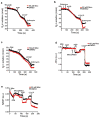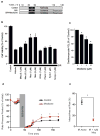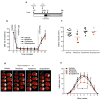Nutrient-sensitized screening for drugs that shift energy metabolism from mitochondrial respiration to glycolysis
- PMID: 20160716
- PMCID: PMC3135002
- DOI: 10.1038/nbt.1606
Nutrient-sensitized screening for drugs that shift energy metabolism from mitochondrial respiration to glycolysis
Abstract
Most cells have the inherent capacity to shift their reliance on glycolysis relative to oxidative metabolism, and studies in model systems have shown that targeting such shifts may be useful in treating or preventing a variety of diseases ranging from cancer to ischemic injury. However, we currently have a limited number of mechanistically distinct classes of drugs that alter the relative activities of these two pathways. We screen for such compounds by scoring the ability of >3,500 small molecules to selectively impair growth and viability of human fibroblasts in media containing either galactose or glucose as the sole sugar source. We identify several clinically used drugs never linked to energy metabolism, including the antiemetic meclizine, which attenuates mitochondrial respiration through a mechanism distinct from that of canonical inhibitors. We further show that meclizine pretreatment confers cardioprotection and neuroprotection against ischemia-reperfusion injury in murine models. Nutrient-sensitized screening may provide a useful framework for understanding gene function and drug action within the context of energy metabolism.
Conflict of interest statement
Figures






Comment in
-
Drug screening: Shifting energy metabolism.Nat Rev Drug Discov. 2010 Apr;9(4):272. doi: 10.1038/nrd3146. Nat Rev Drug Discov. 2010. PMID: 20535845 No abstract available.
Similar articles
-
Meclizine Preconditioning Protects the Kidney Against Ischemia-Reperfusion Injury.EBioMedicine. 2015 Jul 29;2(9):1090-101. doi: 10.1016/j.ebiom.2015.07.035. eCollection 2015 Sep. EBioMedicine. 2015. PMID: 26501107 Free PMC article.
-
Augmentation of glycolytic metabolism by meclizine is indispensable for protection of dorsal root ganglion neurons from hypoxia-induced mitochondrial compromise.Free Radic Biol Med. 2016 Oct;99:20-31. doi: 10.1016/j.freeradbiomed.2016.07.022. Epub 2016 Jul 22. Free Radic Biol Med. 2016. PMID: 27458119 Free PMC article.
-
Bcl-xL knockout attenuates mitochondrial respiration and causes oxidative stress that is compensated by pentose phosphate pathway activity.Free Radic Biol Med. 2017 Nov;112:350-359. doi: 10.1016/j.freeradbiomed.2017.08.007. Epub 2017 Aug 12. Free Radic Biol Med. 2017. PMID: 28807815
-
Medicinal Chemistry Targeting Mitochondria: From New Vehicles and Pharmacophore Groups to Old Drugs with Mitochondrial Activity.Int J Mol Sci. 2020 Nov 18;21(22):8684. doi: 10.3390/ijms21228684. Int J Mol Sci. 2020. PMID: 33217901 Free PMC article. Review.
-
The Role of Mitochondrial Fat Oxidation in Cancer Cell Proliferation and Survival.Cells. 2020 Dec 4;9(12):2600. doi: 10.3390/cells9122600. Cells. 2020. PMID: 33291682 Free PMC article. Review.
Cited by
-
Physiological consequences of complex II inhibition for aging, disease, and the mKATP channel.Biochim Biophys Acta. 2013 May;1827(5):598-611. doi: 10.1016/j.bbabio.2012.12.007. Epub 2013 Jan 2. Biochim Biophys Acta. 2013. PMID: 23291191 Free PMC article. Review.
-
Loss of LUC7L2 and U1 snRNP subunits shifts energy metabolism from glycolysis to OXPHOS.Mol Cell. 2021 May 6;81(9):1905-1919.e12. doi: 10.1016/j.molcel.2021.02.033. Epub 2021 Apr 13. Mol Cell. 2021. PMID: 33852893 Free PMC article.
-
A simple sperm-sexing method that activates TLR7/8 on X sperm for the efficient production of sexed mouse or cattle embryos.Nat Protoc. 2020 Aug;15(8):2645-2667. doi: 10.1038/s41596-020-0348-y. Epub 2020 Jul 17. Nat Protoc. 2020. PMID: 32681149
-
Remodelling of the Mitochondrial Bioenergetic Pathways in Human Cultured Fibroblasts with Carbohydrates.Biology (Basel). 2023 Jul 14;12(7):1002. doi: 10.3390/biology12071002. Biology (Basel). 2023. PMID: 37508431 Free PMC article.
-
Assessing bioenergetic function in response to oxidative stress by metabolic profiling.Free Radic Biol Med. 2011 Nov 1;51(9):1621-35. doi: 10.1016/j.freeradbiomed.2011.08.005. Epub 2011 Aug 16. Free Radic Biol Med. 2011. PMID: 21872656 Free PMC article.
References
-
- Warburg O. On the origin of cancer cells. Science. 1956;123:309–314. - PubMed
-
- Bonnet S, et al. A mitochondria-K+ channel axis is suppressed in cancer and its normalization promotes apoptosis and inhibits cancer growth. Cancer Cell. 2007;11:37–51. - PubMed
-
- Huber R, Spiegel T, Buchner M, Riepe MW. Graded reoxygenation with chemical inhibition of oxidative phosphorylation improves posthypoxic recovery in murine hippocampal slices. J Neurosci Res. 2004;75:441–449. - PubMed
-
- Chen Q, Camara AK, Stowe DF, Hoppel CL, Lesnefsky EJ. Modulation of electron transport protects cardiac mitochondria and decreases myocardial injury during ischemia and reperfusion. Am J Physiol Cell Physiol. 2007;292:C137–147. - PubMed
Publication types
MeSH terms
Substances
Grants and funding
LinkOut - more resources
Full Text Sources
Other Literature Sources

